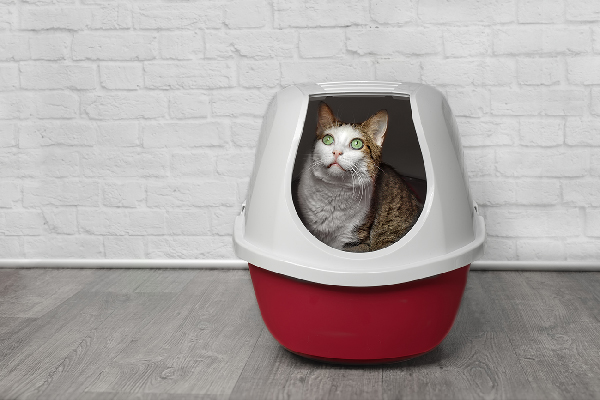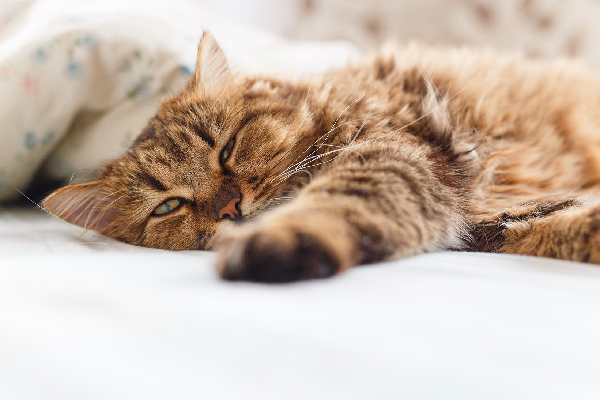Your cat’s kidneys are vital to her overall health. Among their many functions, the kidneys keep her blood pressure in check, help create red blood cells and eliminate waste. Unfortunately, kidney disease in cats becomes more common as our feline friends approach their senior years, with a progressive loss of kidney function creating a number of potentially serious health complications.
The good news is that kidney disease in cats doesn’t always mean a trip over the rainbow bridge is imminent. You’ll want to contact your vet right away if you suspect your cat might be experiencing kidney failure, but here are a few things you need to know about kidney disease in cats.
Symptoms of kidney disease in cats

According to Drs. Tash Taylor and Bonnie Dechant at the Cat Clinic of Johnson County in Lenexa, Kansas, some of the first symptoms of kidney disease in cats include increased thirst and urine output. Other symptoms of kidney disease in cats include vomiting, constipation, weight loss, loss of appetite and weakness. Additionally, some cats afflicted with kidney disease might meow more at night.
Causes of kidney disease in cats
While kidney disease in cats is often a chronic condition that has no cure, kidney failure in cats can also be acute when caused by toxins, trauma or infection. Kidney disease is often called renal failure due to the organs’ vital role in the renal (or urinary) system, which is responsible for removing waste from the body. When the kidneys fail, the renal system cannot function.
Some causes of chronic kidney disease in cats include birth defects, high blood pressure, immune system disorders, infections or congenital diseases. Acute kidney failure can also lead to chronic kidney disease in cats, as can certain diseases like FIV and feline leukemia. Some studies suggest dental disease and diabetes may also contribute to the development of kidney disease in cats, but often an exact cause isn’t clear.
What cats are at risk for kidney disease?
Kidney disease in cats is most common in middle-aged to older felines, though other factors play a role as well. Kidney failure in cats occurs more often in certain breeds, notably Persians, as well as in outdoor cats, who have more ready access to toxins such as antifreeze that can cause acute renal failure.
Diagnosis of kidney disease in cats
To diagnose kidney disease in cats, veterinarians run blood tests and perform urine analysis to determine whether the kidneys are properly filtering and eliminating waste. The tests check the concentration of certain waste products that healthy kidneys normally help regulate.
Treatment of kidney disease in cats
After a cat has been diagnosed with kidney disease, according to Drs. Taylor and Dechant, renal-protective diets can help extend their quality years. These diets have an increase in fat, restricted protein, restricted phosphorus and additional potassium. Feeding canned food may also help in increasing water consumption. As kidney disease in cats progresses and dehydration worsens, Dr. Taylor says the “gold standard” for treatment involves giving fluids from an IV bag, which takes about five minutes and you can do it at home.
“The dose and frequency depend on severity of disease, size of the cat and other systemic illnesses,” Dr. Taylor says. “Many cats get anemic, and I put them on vitamin B supplementation. There is a probiotic (azodyl) that can help remove the toxins through the gastrointestinal tract. It isn’t as effective as fluids, but it can be given if the cat won’t allow fluids, the owner isn’t comfortable with giving fluids, or if the fluids alone aren’t enough. Cats with kidney disease can have difficulty keeping potassium or getting rid of phosphorus. We can supplement potassium and give phosphate binders as needed.”
Prevention of kidney disease in cats
The risk of kidney failure in cats naturally increases as kitty gets older, but there are a few ways to help prevent its onset. Encourage your cat to stay well hydrated by keeping water fresh and easily accessible, and keep your cat’s litter box clean so she will have an easy time urinating. Feeding wet food can also help with hydration — but don’t overdo it, as this can lead to obesity and diabetes, which is a potential risk factor for kidney disease in cats. Finally, be sure you’re keeping up on your cat’s regular veterinary checkups, as early diagnosis of kidney disease is your best bet at keeping your cat healthier longer.
Prognosis of kidney disease in cats
There is no cure for kidney disease in cats, but with good care and appropriate treatment, a cat with kidney disease may live for months or even years.
“The prognosis for kidney disease varies dramatically depending on when it is diagnosed,” Dr. Taylor says. “Early detection and diet change at the appropriate time can extend good quality of life by years.”
Thumbnail: Photography © Vladdeep | iStock / Getty Images Plus.








